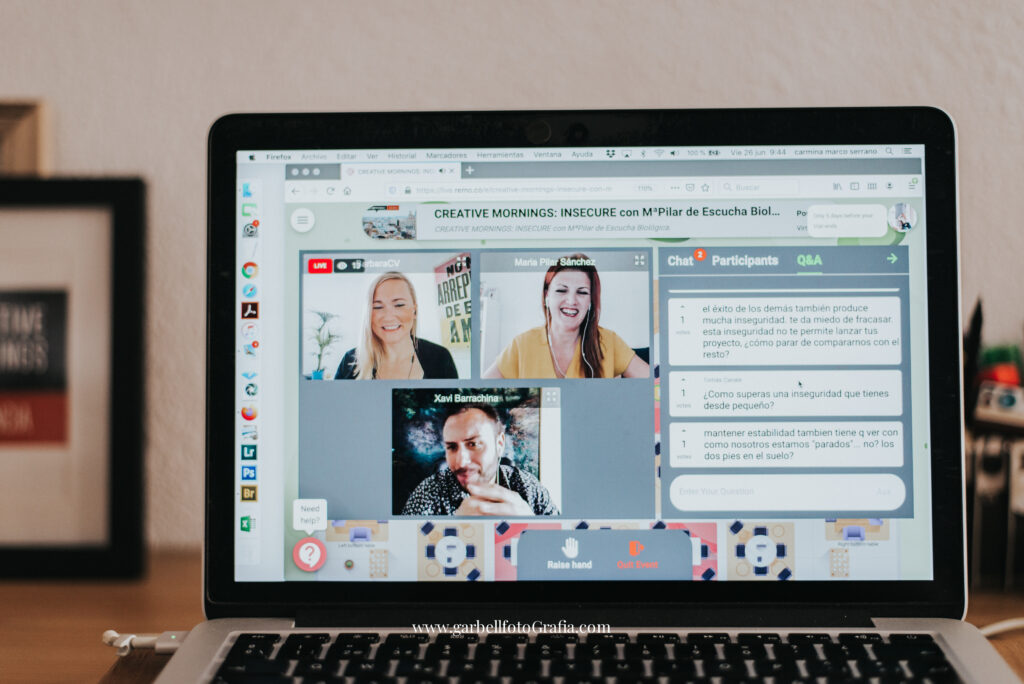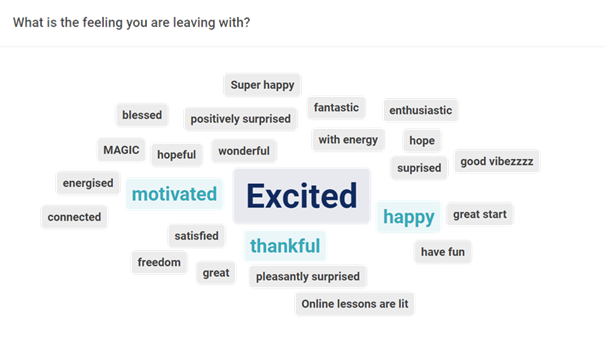The year 2020 challenged all of us as we had to move from one day to the other – with more or less experience – to remote work / remote training / a remote learning environment. Students also found themselves suddenly in a 100% virtual learning environment, many of them being abroad on an exchange semester.
This year, most of the universities continue to focus on virtual exchange semesters, but not many have understood the importance of proper virtual team building to onboard the students. Universities should strive to make virtual onboarding seamless, dynamic and informative – but, this is not easy.
This blog post gives an overview of how we designed and facilitated a virtual team-building event to onboard the virtual exchange students for the IMC Fachhochschule Krems in Austria.
Why is virtual team building and onboarding so important?
For many students going abroad is generally a fantastic experience even though it might be also a bit scary. A semester abroad provides students with the possibilities to get to know other cultures, meet new people from across the globe and step out of their comfort zone. A virtual exchange semester might not provide the students with the cultural on-site experience, of course not, but still, there are many ways in which a virtual exchange semester can help students to develop their cross-cultural communication skills, and self-awareness and of course broaden their global network. But, often lecturers forget about “the incomings”, sometimes we do not properly consider how to include them into a cohort of students who have been studying together maybe for some semesters already. This might lead to frustration, the reason why virtual onboarding for virtual exchange students is of utmost importance.
Virtual onboarding should never be a “one-and-done” video session or even a phone call. As a university, we need to conduct multiple, interactive video sessions that provide an overview of the university, and its programs and services, maybe incorporate meetings with lecturers, staff, and other students and if a buddy system is in place – of course with the buddy. Very often these events are organised by international offices along with a cultural program for the students. Create a structured calendar of activities where the students have the chance to get to know each other.
Not surprisingly, using video is critical to virtual onboarding processes. Still, be aware that your students/participants might be connecting from places where they might not have a bandwidth strong enough for a good video connection or might feel uncomfortable showing what they have in the background. Therefore, be receptive to your students’ situation.

What elements are important for virtual team building and onboarding?
A virtual onboarding process can include scheduled sessions, such as virtual Q&A sessions, one-on-one meetings with the international office and onboarding buddy and a virtual happy hour/lunch/coffee break to get to know other internationals better (e.g. regular hours organised in kumospace, wonder.me, gather.town or any other tool). We designed a 3-hour virtual team building for the incoming students using the following elements and tools:
✨Zoom as our video conference system
✨ Sli.do as our engagement and polling tool / put here our word clouds as visual
✨ Google slides for collaboration in small teams
✨ Kumospace as a way to stimulate virtual socialization after the event
✨ LinkedIn as a platform for social and professional connection and networking. We also encouraged our students to consider the importance of the professional network they are creating and therefore used the following LinkedIn post to connect them.
Often the best choice is to go with shorter events spread over a week or several weeks, rather than having a one-or two day-long virtual event which can be very exhausting. Your onboarding should definitely include regular check-ins and touch points to make sure your international students don’t feel forgotten or overlooked.
Building Engagement and Connections within the context of Internationalization at Home
Onboarding should be interactive to keep your students engaged and connected. Besides, the social side of onboarding is super important. Coach your lecturers to come up with creative ways to support your students to connect well.
We were using the breakout room functionality in multiple ways to keep the students engaged. We can’t retain information if we are sitting for too long. We extensively utilized the functionality within Zoom, such as creating breakout sessions, polling on some of the sessions and engaging on chat. This is where we have seen the most engagement and where students are having fun and connecting.
In our case, we opted for creating always different breakout rooms so as to maximise the number of interactions among the students. In other settings, we might also always use the same breakout room configuration to allow for deeper bonds between the participants.
Some of the tactics that we like to use for maximizing engagement and social connection during these events are:
✨ Encouraging the use of the chat: Students that are not able to, or do not want to participate on camera, will feel included and be more likely to engage and participate.
✨ Telling the participants to rename themselves: This is a great way to engage them right at the beginning of the event. Furthermore, it is a possibility to already make similarities visible. It could for example include the country they are connecting from (e.g.Barbara/Austria), the region/city (e.g. Sveta/Gorizia) or the department that they work in (e.g. Katja/Marketing).
✨ Using objects/props: Is really helpful to get the participants to focus on the event and on the screen again as well as just making them smile.
✨ Asking for non-verbal reactions: Virtual (e.g. reactions function in Zoom) or a “real” (e.g. thumbs up into the camera) reaction might resonate more with some participants than having to answer verbally. Could be used when asking if instructions were clear for example.
✨ Setting up breakout rooms for connections: Working together in small teams might contribute to the students feeling more comfortable with each other which can lead to more engagement and on camera participation.
✨ Music / DJ: Having a DJ set a positive mood when the event starts creates a more friendly and interesting environment. The tension that might be created while waiting for all the participants to join, is immediately taken away. Everybody will feel more comfortable and be more likely to actively contribute.
✨ Make it a magic show connected to culture: If a part of the theoretical input is connected to something so magical as a real magician as we often have it in our events, all eyes and ears will be exactly where you want to have them.
✨ Engaging via email before the event and also afterwards: Preparing the participating students and involved stuff, will ensure a smooth course of the event and get everybody excited for it. Asking for feedback after the event can help to make your future events even better. It is also the best way to get pictures that were eventually taken during the event or other needed content.



How to connect learning and fun? The role of the facilitator and producer
Keeping participants engaged in the virtual space is a lot of work, therefore a thoroughly planned interaction design, a techy producer and super animated facilitators are of utmost importance.
“I am about twice as animated when facilitating virtually compared to an in-presence setting. Nonverbal communication, my digital body language, how I am using facial expressions and looking at the camera, calling out people by name are essential strategies for me.” (Barbara Covarrubias Venegas)
At #virtualspacehero productions we always aim at designing and facilitating EXTRAordinary and memorable events, reason why we always work in tandem with a producer and main facilitator or even co-facilitator to ensure a flawless participants’ experience. The producer focuses on technology (creating the breakout rooms, trouble-shooting, all things tech), whilst the facilitator can totally stay focused on content and connection.
To keep participants engaged, we recommend you use the following frequently :
- ask participants to use the chat function
- ask for signals (raise your hand, non-verbal reactions, asking for energy levels…)
- use something interactive or engaging (the latest) every 20 minutes (breakout room activities where your participants discuss a question for five to eight minutes with other onboarders
- having two facilitators also help to keep attention high
- Nurture opportunities to connect with one another
Our virtual onboarding content was rooted in the key topics: addressing challenges and drivers for working/studying online; virtual collaboration strategies/techniques/tools; time management and project management tips for the online space; engagement impact and management of attitudes. Content delivery was mixed with the interactive assignments where students had to discuss questions in the small virtual teams, come up with solutions and present team insights to the rest of the intercultural teams.
Conclusion: Now is not the time to abandon onboarding: it’s time to double our efforts

First impressions are everything. How you welcome your exchange students and usher them into your university will have an enormous impact on how engaged they are and how quickly they reach their full learning potential. Virtual onboarding is a new practice for most universities. Universities that nail virtual onboarding will have better engagement, retention, and satisfaction among their students. And there’s almost nothing that will turn students into enthusiastic university ambassadors as much as seeing your international team putting in extra effort to make them feel welcomed and valued.
And at the end, your participants will leave with the following feelings,as shown in the picture here 🫶






